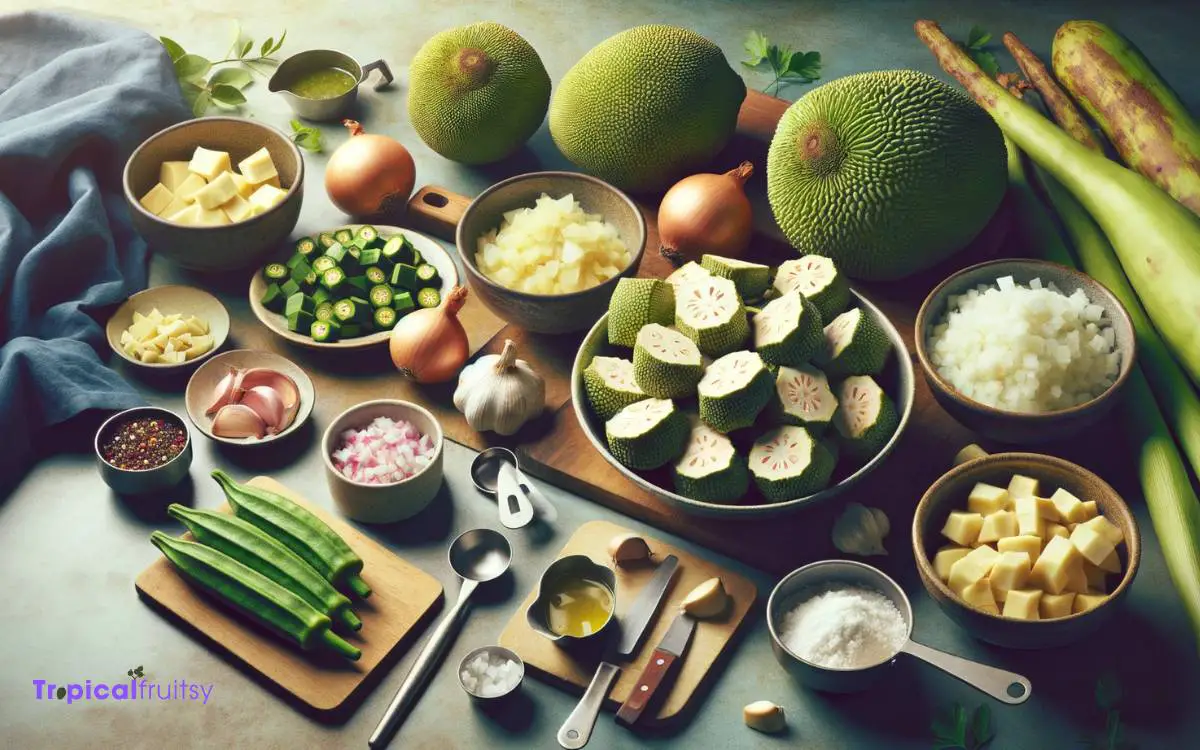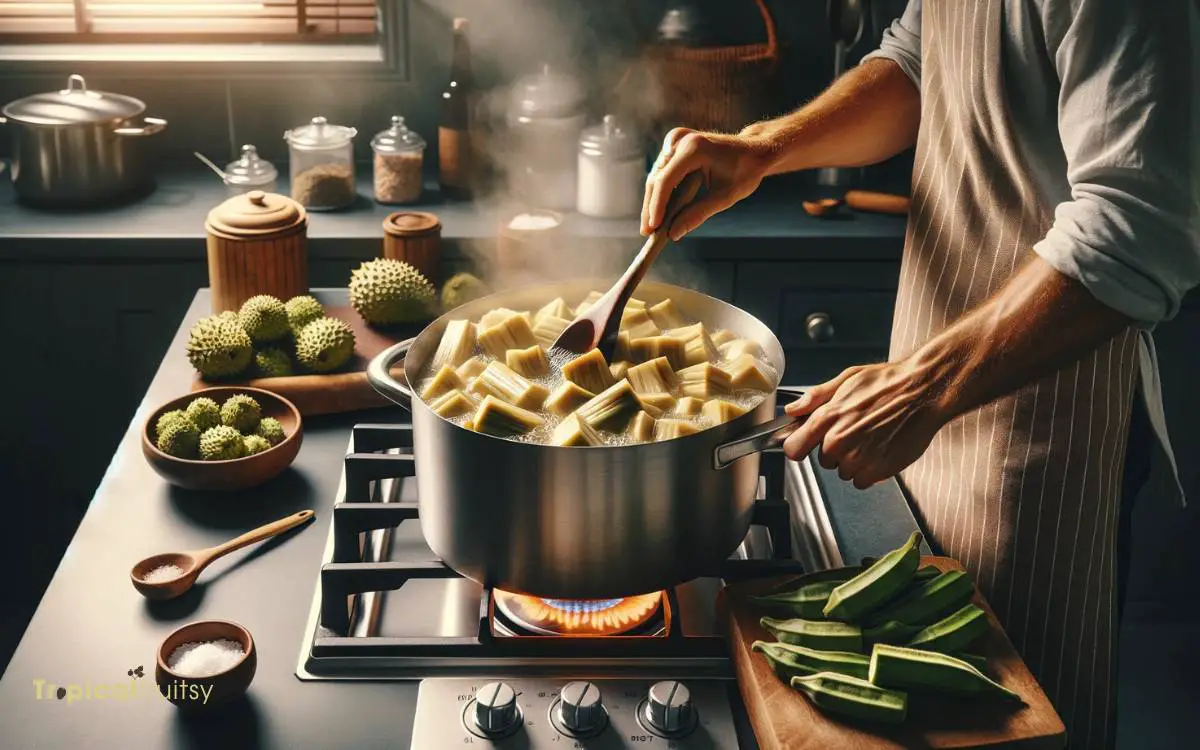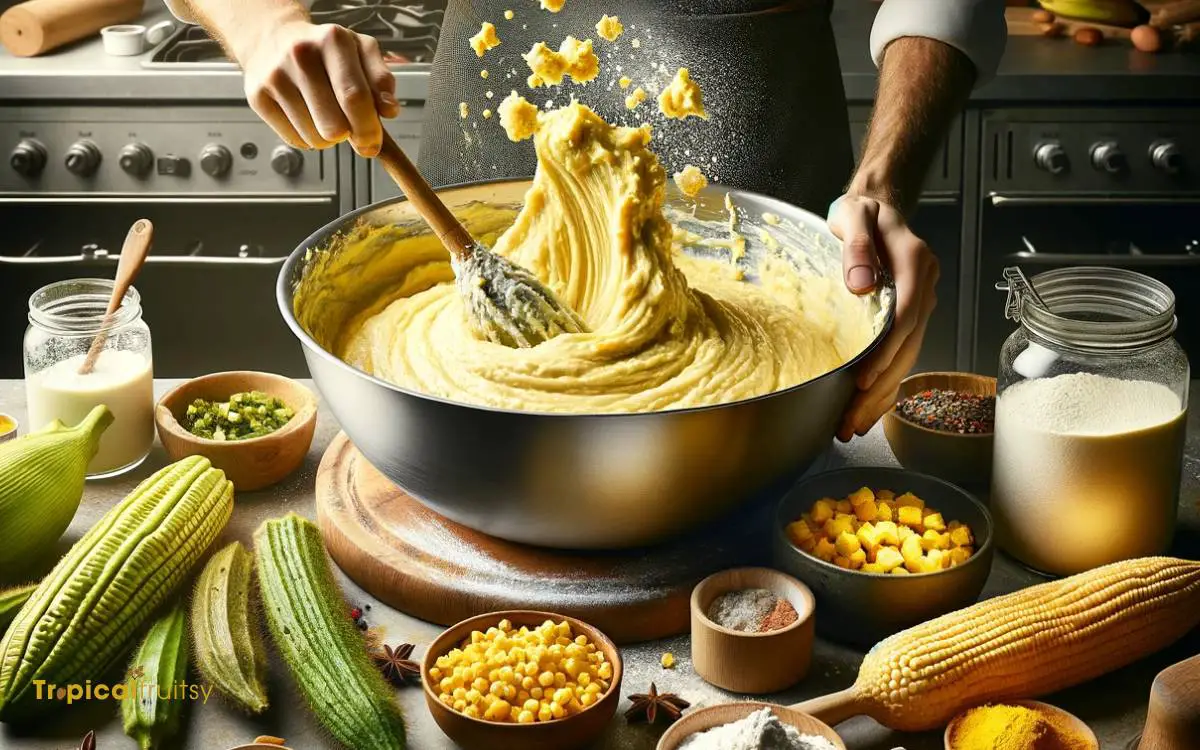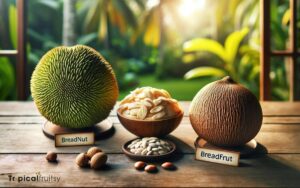How to Make Breadfruit Coucou? 5 Easy Steps!
Breadfruit Coucou, a staple dish in Caribbean cuisine, offers both a unique flavor and a comforting texture.
The dish is made from the starchy tropical fruit known as breadfruit, which is transformed into a smooth, polenta-like mixture.
To embark on the preparation of Breadfruit Coucou, one must first select a ripe but firm breadfruit, ensuring the flesh will be soft and sweet.
The process involves peeling and boiling the breadfruit until tender, then incorporating it with a blend of herbs, spices, and liquids, typically water or coconut milk. This concoction is then methodically stirred to achieve the dish’s signature consistency.
When executed with precision, Breadfruit Coucou can serve as a versatile side, complementing a variety of proteins and vegetables, thus enriching any culinary experience with its delightful Caribbean essence.

Key Takeaway
Step 1: Selecting Your Breadfruit

Begin by choosing a ripe breadfruit, which should have a firm texture and a greenish-yellow skin with a slight give when pressed.
The presence of brown patches can also indicate ripeness, yet it is crucial to avoid fruit with soft spots or an overly pungent odor, as these may signify overripeness or decay.
The optimal breadfruit for coucou is one that is mature but not too soft, as it needs to hold its shape during the cooking process.
Selecting the proper breadfruit is a fundamental step because its flesh provides the dish’s characteristic texture and subtle sweetness.
With the right breadfruit in hand, you are well on your way to creating a traditional and delightful meal.
Next, we will delve into preparing the ingredients for your breadfruit coucou.
Step 2: Preparing the Ingredients

Before initiating the preparation of Breadfruit Coucou, it is essential to ensure that the breadfruit is ripe. This is important because the ripeness of the breadfruit will influence the dish’s texture and flavor.
Accurate measurement of water is crucial when making Breadfruit Coucou. The amount of water used affects the consistency of the coucou, so it is necessary to find a careful balance between firmness and pliability.
Selecting Ripe Breadfruit
Selecting a ripe breadfruit is crucial for the flavor and texture of the coucou. Look for a fruit with green-yellow skin and a slightly soft feel.
This stage of ripeness indicates that the starchy content has developed enough to provide the desired consistency once cooked. The skin shouldn’t have any dark spots, which may suggest overripeness or spoilage.
It’s also important to handle the fruit gently to avoid bruising. A ripe breadfruit emits a mild, sweet fragrance, signaling its readiness for culinary use. When cut open, the flesh should be cream-colored, without any signs of discoloration.
Ensuring that the breadfruit meets these criteria will contribute significantly to the successful preparation of a traditional breadfruit coucou.
Measuring Water Proportion
Having secured a ripe breadfruit, one must now measure an ample quantity of water, which is essential for achieving the smooth consistency characteristic of coucou.
The precise amount of water can vary depending on the breadfruit’s size and desired thickness of the coucou.
Typically, a ratio that leans slightly in favor of water is used, as it can be reduced during cooking.
For visual and practical guidance, consider the following:
- A large pot filled to a third with water, signaling readiness for boiling
- Soft ripples on the water surface, hinting at a gentle simmer
- Steam wafting up, carrying the subtle scent of tropical breadfruit
- A measuring cup at the ready, ensuring precision
- Water at room temperature, to avoid shocking the breadfruit’s texture
With the water measured, attention turns to the aromatic world of herbs and spices, ensuring they are mixed evenly for a harmonious flavor profile.
Mixing Herbs Evenly
All requisite herbs and spices should be gathered in precise quantities to ensure an even distribution throughout the breadfruit coucou mixture.
For a harmonious flavor profile, it is paramount to finely chop or grind the herbs, such as thyme, marjoram, or parsley, to release their essential oils and ensure a uniform texture in the dish.
As you incorporate them into the breadfruit, do so gently and methodically, folding the herbs into the mixture rather than stirring aggressively, to prevent mashing the ingredients.
This careful process helps to maintain the integrity of each element, resulting in a well-balanced dish where no single flavor overpowers another.
With the herbs now seamlessly integrated, we turn our attention to the crucial step of cooking the breadfruit, which will form the base of our coucou.
Step 3: Cooking the Breadfruit

Cooking breadfruit correctly is essential to the success of a Breadfruit Coucou dish. The preparation techniques vary, but they all aim to ensure that the fruit’s texture and flavor are fully developed during cooking.
To achieve the desired consistency, one must be mindful of the optimal cooking time, which can vary depending on the size and ripeness of the breadfruit.
Breadfruit Preparation Techniques
Selecting a ripe breadfruit is the first step in the preparation process, ensuring a smooth and creamy texture for the coucou.
The preparation techniques are pivotal to the dish’s success and involve a series of methodical steps:
- Peel the breadfruit with precision, removing the green outer skin to reveal the starchy, white flesh.
- Slice the fruit into even, manageable wedges, which aids in uniform cooking.
- Submerge the pieces in a pot of boiling water, seasoned with a pinch of salt, to enhance the breadfruit’s natural flavors.
- Simmer until the texture becomes tender, an indication that the breadfruit is ready to be transformed.
- Drain the water thoroughly, as excess moisture can impact the consistency of your coucou.
Optimal Cooking Time
The duration of simmering breadfruit wedges in boiling water typically ranges from 15 to 20 minutes, depending on their size and the desired tenderness.
To ensure even cooking, the wedges should be submerged fully and the pot covered to retain heat.
Regularly check the breadfruit for doneness by inserting a fork into the thickest part of the wedge; it should slide in easily when properly cooked.
Overcooking may result in a mushy texture, while undercooking could leave the coucou with an undesired firmness.
It is crucial to maintain a gentle simmer throughout the cooking process to avoid breaking apart the breadfruit, which would compromise the final texture and presentation of the coucou.
Step 4: Making the Coucou Batter

How does one prepare the essential coucou batter from breadfruit for a traditional Caribbean dish?
The process begins with the careful selection of ripe breadfruit, which is then turned into a malleable and flavorful batter.
The following items are crucial in creating a vivid mental image of the batter-making process:
- Ripe, yellow-fleshed breadfruit, peeled and cored
- A large mixing bowl for combining ingredients
- A sturdy wooden spoon for stirring
- A fine-mesh sieve or food mill for achieving a smooth consistency
- A dash of salt for seasoning the batter
These components come together to form a batter that is at once smooth and accommodating to additional flavors.
Step 5: Combining and Cooking

Upon completing the breadfruit batter, the next step involves meticulously folding in any additional ingredients before cooking it to achieve the desired texture and flavor of the coucou.
To ensure even incorporation, gently mix any herbs, spices, or other flavor enhancers, such as finely chopped onion or minced garlic, into the batter.
The mixture should then be transferred to a greased pan, traditionally a cast-iron skillet, over medium heat. Consistent stirring is imperative to prevent sticking and to promote a smooth, homogenous consistency.
As the coucou cooks, it will thicken and pull away from the sides of the pan, indicating readiness. Once it reaches a firm, polenta-like texture, the coucou is ready to be served. This leads us to consider various serving suggestions to complement the dish.
Can I Use Breadfruit Pulp from Making Juice to Make Breadfruit Coucou?
Yes, you can use breadfruit pulp from making juice to make breadfruit coucou. The breadfruit pulp leftover from the make breadfruit juice recipe is perfect for creating a delicious breadfruit coucou. Simply mix the pulp with cornmeal, butter, and seasonings, then steam until it’s perfectly fluffy and ready to enjoy.
Serving Suggestions
In terms of accompaniments, Breadfruit Coucou pairs excellently with rich, savory dishes such as grilled fish or stewed meats.
The unique texture and subtle sweetness of breadfruit complement robust flavors, making for a delightful culinary balance.
When considering how to serve Breadfruit Coucou, the following suggestions will inspire your presentation and enhance the dining experience:
- Drizzle with a coconut curry sauce for a tropical twist.
- Top with a fresh herb salsa, like chimichurri, to add brightness.
- Serve alongside pickled vegetables for a tangy contrast.
- Pair with a side of roasted root vegetables for added earthiness.
- Accompany with a spicy tomato-based creole sauce to elevate the dish.
These suggestions aim to offer a harmonious blend of tastes and textures that will satisfy any palate seeking a gourmet touch to traditional fare.
Conclusion
The culinary craft of creating breadfruit coucou encapsulates a blend of selecting sumptuous specimens, precise preparation, and careful cooking techniques.
This traditional dish demands diligence in its development, yielding a yield of flavorsome fare.
When adeptly assembled and artfully accompanied, breadfruit coucou not only nourishes but also provides a palatable pleasure that pays homage to its cultural roots. It stands as a sterling staple, steeped in simplicity yet rich in gastronomic grandeur.






